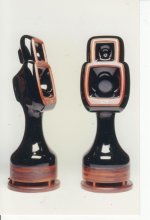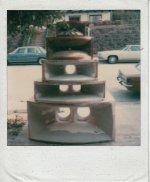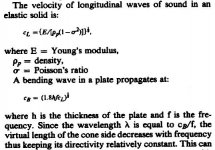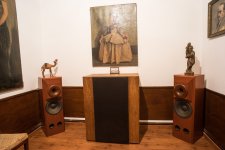Vacuphile,
That is exactly what the transverse wave is describing as Lucky has stated. Indeed the cones are always bending, it is when it gets to a critical point where this becomes abrupt we talk about cone breakup, but on a smaller scale this is happening all the time to a lessor degree. Any mechanical engineers want to jump in here?
That is exactly what the transverse wave is describing as Lucky has stated. Indeed the cones are always bending, it is when it gets to a critical point where this becomes abrupt we talk about cone breakup, but on a smaller scale this is happening all the time to a lessor degree. Any mechanical engineers want to jump in here?
I'm am very surprised. When i was ~20. (more or less at the period tyrannosaurus disappeared, IE 1965) i was in touch with the engineer of their R&D department. Never heard of "Son Audax". The company was "Audax", the most important French loudspeakers company in our country.dvv,
Thanks for the answer on the Son-Audax confusion, I always wondered if it was two separate companies.
According to this clipping, Son Audax was the British subsidiary.
https://books.google.ca/books?id=5N...Q6AEwAg#v=onepage&q=son audax factory&f=false
https://books.google.ca/books?id=5N...Q6AEwAg#v=onepage&q=son audax factory&f=false
Christophe,
The boxes my tweeters came in say this:
La Passion Du Haut_Parleur
Audax
Loudspeaker
Only on this site did I come across the Son-Audax designation. I wondered if it was a branch of the company or something as all my literature and the major book on all the different models just say Audax.
ps. Just another reason that corporate monopolies are so bad, they will just buy up any competition only to shut it all down. Consolidation is just business as usual everywhere it seems.
The boxes my tweeters came in say this:
La Passion Du Haut_Parleur
Audax
Loudspeaker
Only on this site did I come across the Son-Audax designation. I wondered if it was a branch of the company or something as all my literature and the major book on all the different models just say Audax.
ps. Just another reason that corporate monopolies are so bad, they will just buy up any competition only to shut it all down. Consolidation is just business as usual everywhere it seems.
Last edited:
Beware, after "the son of Audax", you could have to face "The revenge of Audax" !I wondered if it was a branch of the company
They were the supplier for Elipson ORTF* enclosures with this tweeter able to go up to 40KHz:

*ORTF = "Office de radio television Française", the official government organisation with the monopoly of diffusion.
Last edited:
Vacuphile,
That is exactly what the transverse wave is describing as Lucky has stated. Indeed the cones are always bending, it is when it gets to a critical point where this becomes abrupt we talk about cone breakup, but on a smaller scale this is happening all the time to a lessor degree. Any mechanical engineers want to jump in here?
The transverse wave of course exists in any real material. It is not the dominant acoustic coupling mechanism. As you are working on minimizing the effects so have others even before Rice & Kellog.
The issue as I followed it started with group delay. This raised the issues of driver blending and behavior of what is often called the "acoustic center."
Distortion as you know has many sources from the magnetic drive system through the cone and even from the surround etc.
Luckythedog you brought out a set of definitions that has always eluded me: What is REAL delay? Richard Heyser pointed this out more than 45 years ago in one of his papers on loudspeaker delay. I never could get a REAL handle on group delay vs phase delay vs REAL delay. Do you know the differences?
Simon,
Yes we have gone off course of course here, we aren't talking about GD at all at this point.
Yes we have gone off course of course here, we aren't talking about GD at all at this point.
John,
that is one of the articles in the AES Loudspeaker Compendium that I listed below for Richard. Very old but still applicable today.
that is one of the articles in the AES Loudspeaker Compendium that I listed below for Richard. Very old but still applicable today.
Well, Kindhornman, do you know what the specific differences are? Richard Heyser always warned me about too much dependence on group delay calculations.
Frankly speaking, I think you are making things up.
No
Luckythedog is correct
The complicated truth is that within a solid elastic body there are as many pressure wave velocities as there are deformation modes.
To add to the complexity, when one or more dimension of the body become smaller than the disturbance's wavelength, many things change from the bulk material case (mode interaction and mode conversion), resulting in lowering of on-axis propagation velocity and other phenomena, the severity of which depends on the elastic properties of the body.
For a speaker’s cone case, see the attachment from the great Daniel Queen (US patent No:4134471)
George
Attachments
Last edited:
They look like pieces of Chess.No wheels on mine!
Why your speakers seems inclined to the ceiling ?
Christophe, two reasons. One to slightly correct for the time alignment between the two devices and the second one was purely cosmetic. The off axis response, and that is not really that much angle is not changing at that angle, you wouldn't notice they are tilted back. I could say something unreal like it was to change the floor bounce but then I would be lying!
John,
Got to go pick up a kid but should be back and will try and answer you if I think I can give a coherent answer for you. I have to admit I haven't read that article in years, you should see what that manual looks like!
John,
Got to go pick up a kid but should be back and will try and answer you if I think I can give a coherent answer for you. I have to admit I haven't read that article in years, you should see what that manual looks like!
Funny, I use to close my two enclosures more than necessary to be in the axis of the listener. it helps to enlartge the optimum position. So, I'm too a little off axis too, and I find-it better for the Horns 🙂.Christophe, two reasons. One to slightly correct for the time alignment between the two devices and the second one was purely cosmetic. The off axis response, and that is not really that much angle is not changing at that angle, you wouldn't notice they are tilted back. I could say something unreal like it was to change the floor bounce but then I would be lying!
Attachments
Last edited:
Some interesting pictures of cone motion from B&W...
Tools of the trade - laser measurements | Society of Sound
Tools of the trade - laser measurements | Society of Sound
I never could get a REAL handle on group delay vs phase delay vs REAL delay. Do you know the differences?
REAL delay is not an actual term, so it can be defined any way you like. Group versus phase delay is explained in any elementary physics text on vibrations and waves. Surprisingly, Wikipedia has a cogent explanation, and they even brought up the classic Blauert paper on audibility thresholds.
Group delay and phase delay - Wikipedia, the free encyclopedia
Well, this is how I visualise the common sense differences as they apply to audio, but really they are physics concepts which maybe don't really cross over to common sense that well I think:Luckythedog you brought out a set of definitions that has always eluded me: What is REAL delay? Richard Heyser pointed this out more than 45 years ago in one of his papers on loudspeaker delay. I never could get a REAL handle on group delay vs phase delay vs REAL delay. Do you know the differences?
There's a natural thing called a 'Gaussian pulse' which has an amplitude of defined shape (a 'bell' shape), which can be modulated by a frequency of interest (f) to form an AM pulse which has a Gaussian amplitude envelope modulating frequency f.
If this pulse passes through an electronic or mechanical filter with group delay, the envelope will change shape and its peak will shift in time (forward or backward) by a time equal to the group delay. A short gaussian pulse of frequency f will have an amplitude peak which arrives before or after the original by an amount equal to the group delay. Time machine, anybody ?
Phase delay is simply the phase response of an electronic or mechanical filter, expressed as a time - ie a lead or lag time for steady state sinusoids of frequency f.
HTH!
- Status
- Not open for further replies.
- Home
- Member Areas
- The Lounge
- John Curl's Blowtorch preamplifier part II



